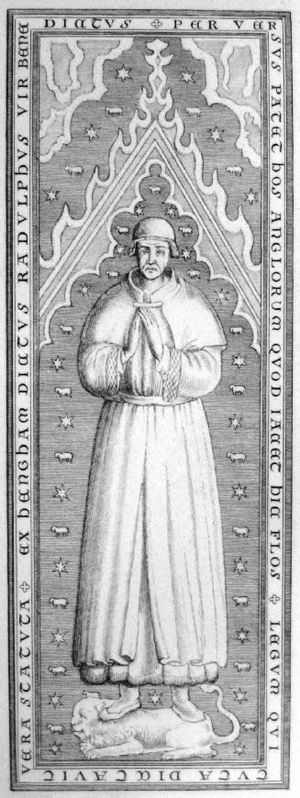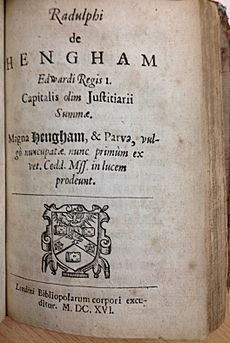Ralph de Hengham facts for kids
Quick facts for kids
Sir Ralph de Hengham
|
|
|---|---|

A 17th-century engraving by Wenceslaus Hollar of Ralph de Hengham's monumental brass (no longer extant) at St Paul's Cathedral, London
|
|
| 12th Lord Chief Justice of England | |
| In office 1274–1290 |
|
| Monarch | Edward I |
| Chancellor | Walter de Merton Robert Burnell |
| Preceded by | Martin of Littlebury |
| Succeeded by | Gilbert de Thornton |
| 18th Chief Justice of the Common Pleas | |
| In office 1301–1309 |
|
| Monarch | Edward I Edward II |
| Chancellor | John Langton William Greenfield William Hamilton Ralph Baldock |
| Preceded by | John of Mettingham |
| Succeeded by | Sir William Bereford |
| Personal details | |
| Born | 1235 |
| Died | 18 May 1311 (aged 75–76) |
| Resting place | Old St Paul's Cathedral, London 51°30′49″N 0°5′54″W / 51.51361°N 0.09833°W |
| Nationality | English |
Sir Ralph de Hengham (born 1235, died May 18, 1311) was an important English church leader and judge. He held many high positions in England's legal system during the Middle Ages.
Contents
Ralph de Hengham's Life and Work
Early Career in Law
Ralph de Hengham began his legal career as a clerk. Before 1255, he worked for Giles of Erdington, a judge in the Common Bench. By 1260, he moved to work for the King's Bench.
He later served Richard of Middleton, another important legal figure. Hengham worked with Middleton on special court circuits called Eyre in 1262 and again from 1268 to 1269. When Middleton became the Lord Chancellor in 1229, it helped Hengham's career grow quickly.
In 1271, when he was only in his mid-thirties, Hengham became a junior judge on an Eyre circuit. By 1272, he was leading his own Eyre circuit as a senior judge. After King Henry III died, all Eyre circuits stopped. Hengham then became a junior judge in the Common Bench in 1273.
For about a year and a half, Hengham also served as an assize judge in the West Midlands.
Becoming Chief Justice
In 1274, Ralph de Hengham was promoted to Chief Justice of the King's Bench. This was a very important position, and he held it until 1290.
Around 1289 and 1290, many judges faced problems. Hengham was removed from his position in 1290. This happened because of a problem in just one case, seemingly due to a small mistake. He had to pay a large fine of 10,000 Marks over five years to be released and pardoned.
This large fine showed how wealthy Hengham was. He held important church positions in places like Hereford, Lichfield, and St Paul's. He also owned land in several counties. There's a story that his fine helped pay for a clock tower in London, which some say later led to Big Ben. However, there is no clear proof of this from that time.

Later Years and Legacy
Ralph de Hengham regained the King's trust in the late 1290s. In September 1300, he was appointed as an Assize judge again. By the end of that year, he rejoined the King's council.
After another judge, John of Mettingham, died in 1301, Hengham was chosen to replace him. He became the Chief Justice of the Common Pleas. Records show he was rarely absent from this role. King Edward II reappointed him in 1307, but he was replaced by Sir William Bereford in 1309.
Hengham was known for explaining legal points to students and apprentices after cases. He is also believed to have written Hengham parva (Small Hengham). This book was a collection of lectures he gave to junior law students. He might also have written Hengham magna (Great Hengham), though this is less certain.
He also likely wrote two other legal guides. One was about quo warranto law for judges in Northamptonshire in 1285. The other was a response to a question from judges serving in Ireland.
Ralph de Hengham lived for about two years after retiring from the Common Bench. He passed away on May 18, 1311. He was buried in the quire area of Old St Paul's Cathedral.

